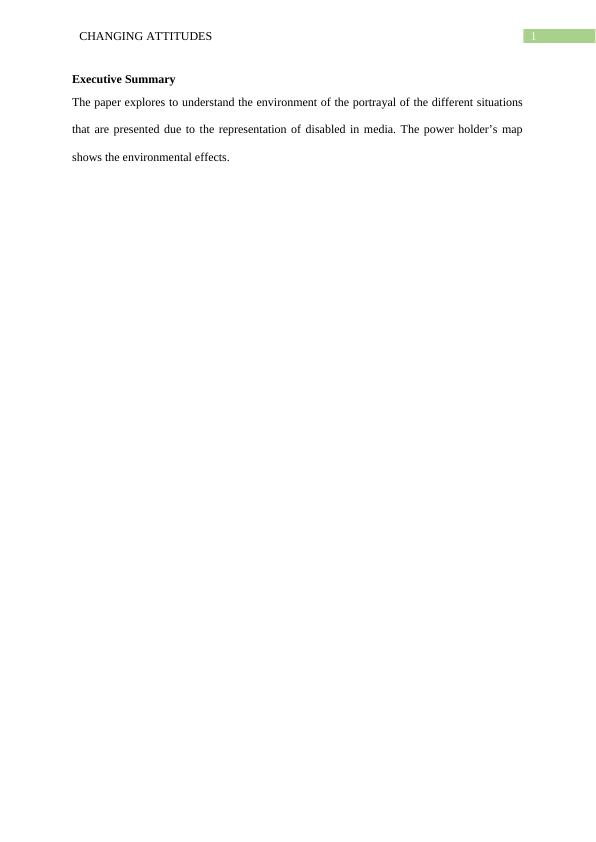Changing Attitudes: Impact of Media Representation on Disabled Individuals
Added on 2023-06-14
6 Pages1057 Words140 Views
Running Head: CHANGING ATTITUDES
CHANGING ATTITUDES
Name of the Student
Name of the University
Author Note
CHANGING ATTITUDES
Name of the Student
Name of the University
Author Note

1CHANGING ATTITUDES
Executive Summary
The paper explores to understand the environment of the portrayal of the different situations
that are presented due to the representation of disabled in media. The power holder’s map
shows the environmental effects.
Executive Summary
The paper explores to understand the environment of the portrayal of the different situations
that are presented due to the representation of disabled in media. The power holder’s map
shows the environmental effects.

2CHANGING ATTITUDES
The environment of the article clearly focusses on the development of the society
keeping in mind the portrayal of the disabled in the media and its impacts on the different
societies. The media is a strong source of dissemination of the information around the world
which helps in the formations of the perceptions regarding the disabled individuals. One of
the major issues highlighted are the effect that the portrayal in the media have on the disabled
people (Pearson and Trevisan 2015). The society nay become very understanding of their
plights but it is unpleasant for the individuals who want to be treated as equals.
Underlining a handicapped person's valiance, however good natured, can serve to
escalate differentiate, which in this way braces a clear sentiment detachment. More especially
about impair there is a Dutch academic examination Disability, Prejudice and Reality TV that
speaks to the diserse nature of the issues while overseeing standard gatherings of spectators
seeing a Dutch unscripted TV show which had a couple of individuals with physical
insufficiency. On one side they found that having people with insufficiency appearing by
chance with no unquestionable thought paid to them is helpful for normalizing handicap as a
segment of consistent every day presence, yet it can in like manner diminish the impact as the
powerlessness delineation gathers that inadequacy is a non-issue that has no impact on
people's lives (Haller and Zhang 2014). A Nepalese report kept an eye on the thought of
positive portrayal of failure in the pervasive children's program Khushi Ko Sansar (translates
to "Happy World") which showed up in any occasion without a moment's hesitation positive
changes in standard attitudes towards kids with disable. The makers saw this might be a
feasible technique in making countries where there are inconsequential sponsorships and
resources for people with debilitate.
Clearly there ought to be more people with inadequacy appearing on TV, over
different kinds, as a component of standard programming. Regardless, there is a hazard that
this thought starting at now showed can essentially strengthen standard speculations about
The environment of the article clearly focusses on the development of the society
keeping in mind the portrayal of the disabled in the media and its impacts on the different
societies. The media is a strong source of dissemination of the information around the world
which helps in the formations of the perceptions regarding the disabled individuals. One of
the major issues highlighted are the effect that the portrayal in the media have on the disabled
people (Pearson and Trevisan 2015). The society nay become very understanding of their
plights but it is unpleasant for the individuals who want to be treated as equals.
Underlining a handicapped person's valiance, however good natured, can serve to
escalate differentiate, which in this way braces a clear sentiment detachment. More especially
about impair there is a Dutch academic examination Disability, Prejudice and Reality TV that
speaks to the diserse nature of the issues while overseeing standard gatherings of spectators
seeing a Dutch unscripted TV show which had a couple of individuals with physical
insufficiency. On one side they found that having people with insufficiency appearing by
chance with no unquestionable thought paid to them is helpful for normalizing handicap as a
segment of consistent every day presence, yet it can in like manner diminish the impact as the
powerlessness delineation gathers that inadequacy is a non-issue that has no impact on
people's lives (Haller and Zhang 2014). A Nepalese report kept an eye on the thought of
positive portrayal of failure in the pervasive children's program Khushi Ko Sansar (translates
to "Happy World") which showed up in any occasion without a moment's hesitation positive
changes in standard attitudes towards kids with disable. The makers saw this might be a
feasible technique in making countries where there are inconsequential sponsorships and
resources for people with debilitate.
Clearly there ought to be more people with inadequacy appearing on TV, over
different kinds, as a component of standard programming. Regardless, there is a hazard that
this thought starting at now showed can essentially strengthen standard speculations about

End of preview
Want to access all the pages? Upload your documents or become a member.
